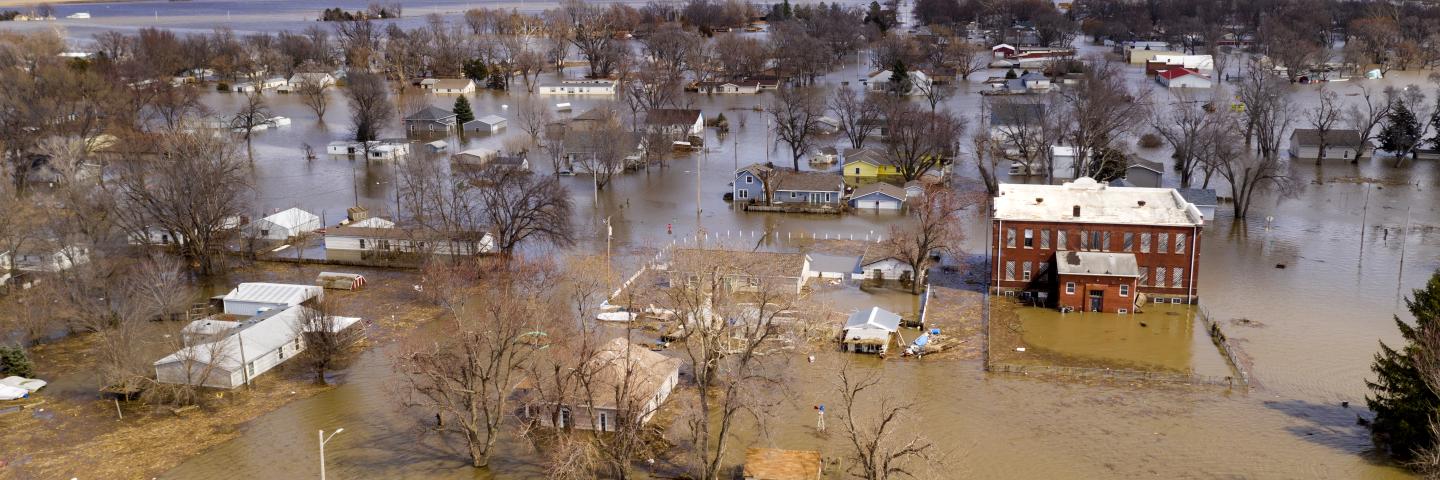EWP Sponsor Resources
Resources for EWP Program assistance.

NRCS administers the Emergency Watershed Protection EWP Program, which is designed for emergency recovery work, including the purchase of floodplain property buyouts.
The U.S. Department of Agriculture’s Natural Resources Conservation Service (NRCS) administers the Emergency Watershed Protection Program (EWP) to assist project sponsors in protecting lives and property from flooding or soil erosion after a natural disaster. In communities impacted by constant flooding or severe erosion due to a natural disaster, a property buyout might be the best solution.
EWP Recovery Buyouts are used where structural projects to reduce threats from flooding and erosion are not cost-effective and/or beneficial. Once NRCS determines that buying a flood-prone property (for example) would provide the pivotal solution and sustainable course of action for a community, EWP has the authority to provide local sponsors with financial assistance to purchase and preserve the land for the purpose of restoring the natural environment.
NRCS may provide project sponsors up to 75 percent (and up to 90 percent for limited resource areas) of:

Frequent flooding made roads in Luther's Corner impassable. Properties purchased under the EWP Recovery Buyout program will revert back to nature increasing flood storage capacity in the watershed.
Properties are potentially eligible if they meet all of the following requirements for a buyout:
Structures may be relocated to an area NOT threatened by flooding or erosion, if it is determined to be an economic and feasible option.
EWP assistance does not require a disaster declaration by FEMA.
Buyouts are effective in preventing future damage, make residents safer and protect communities. Once purchased, the land is returned to a natural open space where it provides the added benefit of absorbing storm runoff, reducing future flooding, and providing wildlife habitat.
All EWP work must provide protection from future flooding or soil erosion; reduce threats to life and property; restore the natural function to the watershed; and be economically and environmentally sound.
If property has been damaged by flooding or threatened by severe erosion and meets the eligibility requirements, it may qualify for EWP assistance. To request assistance, work with a local project sponsor and contact your USDA-NRCS EWP Program Manager.
A Project Sponsor must be a State or political subdivision thereof, a federally-recognized Tribe or Tribal organization, or unit of local government with a legal or conservation interest in the land. Cities, Counties, and state conservation districts are the most common sponsors of EWP projects.
Project sponsors must be able to:
Contact your local NRCS office to learn more about EWP buyouts.
Contact your local service center to start your application.
Do you farm or ranch and want to make improvements to the land that you own or lease?
Natural Resources Conservation Service offers technical and financial assistance to help farmers, ranchers and forest landowners.

To get started with NRCS, we recommend you stop by your local NRCS field office. We’ll discuss your vision for your land.
NRCS provides landowners with free technical assistance, or advice, for their land. Common technical assistance includes: resource assessment, practice design and resource monitoring. Your conservation planner will help you determine if financial assistance is right for you.
We’ll walk you through the application process. To get started on applying for financial assistance, we’ll work with you:
Once complete, we’ll work with you on the application, or CPA 1200.
Applications for most programs are accepted on a continuous basis, but they’re considered for funding in different ranking periods. Be sure to ask your local NRCS district conservationist about the deadline for the ranking period to ensure you turn in your application in time.
As part of the application process, we’ll check to see if you are eligible. To do this, you’ll need to bring:
If you don’t have a farm number, you can get one from USDA’s Farm Service Agency. Typically, the local FSA office is located in the same building as the local NRCS office. You only need a farm number if you’re interested in financial assistance.
NRCS will take a look at the applications and rank them according to local resource concerns, the amount of conservation benefits the work will provide and the needs of applicants. View Application Ranking Dates by State.
If you’re selected, you can choose whether to sign the contract for the work to be done.
Once you sign the contract, you’ll be provided standards and specifications for completing the practice or practices, and then you will have a specified amount of time to implement. Once the work is implemented and inspected, you’ll be paid the rate of compensation for the work if it meets NRCS standards and specifications.